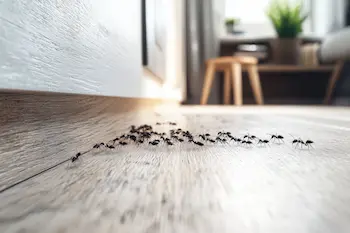
The Problem with Ants
Ants are famous for their never ending quests for food and water, leaving behind scent trails to guide their colony to any discovered resources. This teamwork often leads to rapid infestations, potentially with no warning. For pet owners, dealing with ant problems can be challenging, as many conventional pest control methods rely on chemicals that can harm animals. Fortunately, there are pet-friendly solutions that effectively manage ants without putting your furry friends at risk. This guide explores a variety of effective strategies to combat ant infestations while prioritizing your pets’ well-being.
Natural Strategies to Remove Ants
1. Essential Oils
Essential oils provide a natural and efficient way to repel ants. Scents such as peppermint, tea tree, and citrus disrupt ants’ scent trails, making it harder for them to return to your home.
How to Use:
- Mix 10-15 drops of your chosen essential oil (e.g. peppermint) with 1 cup of water.
- Add a teaspoon of dish soap to help the solution stick to surfaces.
- Spray the mixture along ant trails, entry points, and areas where ants are active.
- Reapply as necessary to maintain this pet-friendly ant deterrent.
2. Vinegar Solution
Vinegar is a powerful and pet-friendly way to keep ants at bay. Its strong smell interferes with their scent trails, making navigation more difficult.
How to Use:
- Combine equal parts vinegar and water in a spray bottle.
- Spray the solution directly on ants and along their trails.
- Wipe down surfaces with the mixture to remove scent trails and prevent ants from returning.
3. Food-Grade Diatomaceous Earth
Food-grade diatomaceous earth is a natural powder derived from the fossilized remains of microscopic aquatic organisms. It is harmless to both humans and pets, yet highly effective in eliminating ants and other pests by absorbing the oils from their bodies, leading to dehydration and death.
How to Use:
- Lightly dust diatomaceous earth around entry points, along ant trails, and in areas where ants are often seen.
- Reapply as needed, especially after cleaning or if the powder gets damp.
4. Baking Soda and Sugar
This method takes advantage of ants’ attraction to sugar and the abrasive qualities of baking soda to eliminate them at the source.
How to Use:
- Mix equal amounts of baking soda and powdered sugar.
- Place the mixture in shallow dishes or lids and set them near ant trails.
- Ants will transport the mixture back to their colony, addressing the problem at its root.
Baking soda is generally safe for pets in small quantities, but it’s wise to use this solution sparingly to avoid unnecessary exposure.
While natural solutions such as essential oils, vinegar, diatomaceous earth, and baking soda can be helpful in managing ant infestations, they typically offer only temporary relief. For lasting results, pairing these methods with professional pest control services ensures complete elimination of ants and prevents future infestations. If you’re facing a persistent ant problem, visit our ant extermination page for expert advice and solutions.
Need Pet-Friendly Ant Removal Strategies?
Protecting Pet Food
Creating a barrier around your pet’s food bowl is an easy and effective way to keep ants away from their meal. One method is to place the bowl in a shallow tray filled with water, since ants can’t cross the water barrier. Alternatively, you can apply a layer of petroleum jelly around the base of the bowl, creating a slippery surface that ants can’t climb.
Maintaining cleanliness in the feeding area is just as important for keeping ants at bay. Quickly clean up any spilled food or crumbs, and store pet food in sealed containers to make it less accessible to ants.
Another dependable option is using ant-resistant containers designed to safeguard dry pet food from infestations. Make sure the lid is tightly secured after each use to provide the best protection.
Outdoor Removal Strategies
There are several pet-friendly methods to remove ants from your yard. One powerful technique is to pour hot water directly into the nest, focusing on the entrance. Repeat this process as necessary until the colony is eliminated.
Another natural solution is to use citrus peels, such as orange or lemon, to deter ants. Blend the peels with water to make a paste, then apply it around ant nests and entry points. The strong citrus scent disrupts their scent trails, making it difficult for them to navigate back to the colony.
Cinnamon is also an excellent pet-friendly option for keeping ants away. Simply sprinkle ground cinnamon around ant nests or along the perimeter of your yard. Reapply after rain or watering to maintain its effectiveness.
Borax Usage
Borax is an effective remedy for eliminating ants, but it can be harmful to pets if ingested. To use borax safely, it’s important to take precautions to protect your animals.
How to Use Borax Safely:
- Mix one part borax with three parts powdered sugar.
- Place the mixture in a container with small openings that allow ants to access it while keeping pets out.
- Position the container in locations that are out of your pet’s reach, such as high places or hidden areas like under cabinets.
This method targets ant colonies while ensuring that borax stays away from your pets. If these placement options aren’t ideal for your situation, contact our team for an inspection and personalized advice on effective alternatives.
When to Reach Out
If ants continue to invade your home despite your efforts with pet-friendly methods, the experts at Suburban Exterminating are here to provide reliable, long-term solutions. Our skilled technicians will perform a comprehensive inspection of your property to locate the source of the infestation and identify the specific ant species. We carefully check key areas, while tracing entry points, feeding sites, and trails to uncover nests.
To tackle the problem, we use a range of targeted treatment strategies. These may include applying insecticide sprays or powders in hard-to-reach places, such as cracks and crevices, ensuring the area remains safe for pets. Another effective method is ant baiting, where worker ants carry the bait back to the colony, addressing the infestation at its core. All treatments are tailored to the type of ant and the extent of the problem.
In addition to treatment, we focus on prevention through exclusion methods. This involves sealing cracks, gaps, and other potential entry points, as well as trimming nearby vegetation to limit access for ants.
For ongoing protection, we offer personalized prevention advice to help you maintain a pest-free environment. Our experts will help you protect your home from future infestations and guide you on proper maintenance practices. Ready to reclaim your space and permanently eliminate ants? Contact us today for professional assistance.
Back to Ant Exterminators – Control – Removal